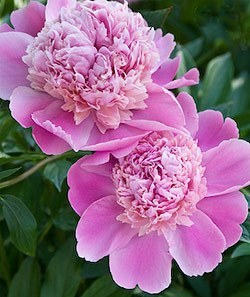When it comes to peony care, it’s best to plant, transplant and divide these long-lived perennials in early fall.
However, spring is also a good time to plant if you have bought young container-grown plants. But if you have mature clumps that need transplanting or division, save that job for early fall.
Peony care – planting and watering tips

Double flowered peonies need staking
When planting bare root or pot-grown peonies, give each clump a sunny spot in the garden that’s at least three feet in diameter and well away from tree roots.
September to early October is the ideal time to plant peonies. That’s when specialty growers offer the best selection of desirable peony cultivars.
Peonies like well-drained soil – standing water is fatal – and they are quite drought resistant.
However, newly planted clumps do need regular watering in their first summer. Be sure to water them in dry springs and in summer if conditions are very hot and dry.
How to plant bare-root peonies
Peonies for fall planting come as thick brown tuberous roots with three to five eyes – the small, reddish buds near the top.
- If the peony roots seem a little dry when you get them, soak them overnight in a bucket of water before planting.
- To plant, dig a hole large enough to spread the roots and incorporate well-rotted organic matter.
- Place the roots in ground so that the eyes are just one to two inches below the soil’s surface. Backfill with the remaining soil and water well. Planting too deeply results in fewer flowers.
Container grown plants
If you are planting a container-grown plant, place it in the planting hole so that the soil level in the container is even with the level in the bed.
Peony care – staking and deadheading
There’s nothing sadder than peony flowers pelted into the mud by a summer thunderstorm. There is no doubt that the tall, double hybrids need staking. (To avoid this job, choose single-flowering peonies.)
When you are staking, add hoops or supports in early spring when the leaves begin to emerge from the ground – otherwise it will be too late, as peonies grow very quickly.
Unfortunately, sometimes ready-made supports are too short to support heavy flowers on taller stems.
The best way to support these stems is to set four bamboo stakes into the ground around the outside of the plant and weave garden twine through the stems and leaves from one side of the plant to the other. Aim for a crisscross pattern that works like a net to keep stems and blooms upright.
As for stems that won’t co-operate, just cut them and enjoy the flowers in a vase.
After the flowers have finished, cut off the entire flower stem, and make your cut well inside the plant, so you don’t see the cut-off tips. Peonies will only bloom once, but their foliage usually stays attractive until the end of the growing season.
Peony success – fall and winter care
Like flower bulbs, for best bloom, peonies need a period of winter chilling while they are dormant. This is why they don’t thrive in subtropical climates.
Fall peony care means cutting down and removing the leaves after frost kills them. This helps to prevent infection, as the old foliage can harbor fungal pathogens such as botrytis that can damage peonies in cold wet weather.
If you get little or no snow cover and live in a very cold climate – average minimum temperatures below -20 degrees F (-28 degrees C) – add a layer of winter mulch. Fall leaves or Christmas tree boughs work well.
Peony care – how and when to divide
This is a perennial that rarely needs division – a peony clump will grow happily in same garden spot for many years. However, if you notice that your plants have stopped flowering well, they may have become shaded out by nearby trees and shrubs or become overcrowded.
To divide them – the best time to do this job is in the early fall – carefully dig out the clump and wash away the soil to expose the eyes. With a clean, sharp spade or knife, divide the clump into sections, making sure that each division has three to five eyes and good roots. Replant your divisions as quickly as possible.
Peony Questions Answered
What to do if your peonies aren’t flowering well
Will the ants on my peony cause problems?
Can you grow peonies from seed?
Spots on peony leaves – what to do about fungal diseases




